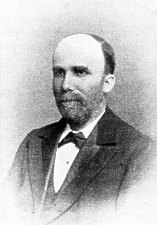
MR. DAVID McDOWALL
Secretary and Manager, Manx Northern Railway
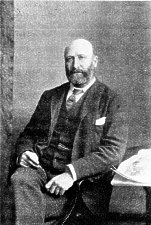
MR. C. B. NELSON, J.P., C.P.
Chairman, Manx Northern Railway
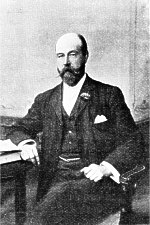
MR. J. M. CRUICKSHANK
Director, Manx Northern Railway
By BRUNEL REDIVIVUS
THE Railways of the Isle of Man possess many features of interest to the railway excursionist and those readers of the RAILWAY MAGAZINE who have not yet decided where to spend their summer vacation, could do a good deal worse than pay a visit to Mona's Isle, and so gain an insight into the railway economy of this interest-ing appendage of the British Empire.
There are two (or rather three, as will be explained later) railway systems serving Manx-land. The two are known as the Manx Northern Railway and the Isle of Man Railway. In this article we purpose to give some details of the former.
In the first place, since the island must be reached by boat, it will be as well to give a few particulars of the means of reaching Mona. There are swift steamers from ports in England, Scotland, Wales, and Ireland.
The island is in regular steam communication with Greenock, Glasgow, and Ardrossan, in Scotland; with Whitehaven, Barrow, Silloth, Fleetwood, and Liverpool, in England; and with Kingstown, Dublin, and Belfast, in Ireland; and, besides, has occasional communication with Garliestown, in Scotland ; Blackpool and Southport in Lancashire; Llandudno, in Wales; and Greenore, in Ireland.
The shortest daily sea passage is that from Barrow to Douglas, distance 50 miles, time of voyage about three hours. The Furness Railway runs fast trains to Barrow from all parts of its system in connection with these steamers, and if the London and North Western Railway would join hands with Mr. Aslett, a through express could be run daily from Euston to Barrow, via Carnforth, a distance of 265 miles in 5½ hours, so that it would be possible for passengers leaving London, say at 9 a.m., to arrive in Douglas at 5.30 p.m. Such a train, we feel sure, would prove most remunerative, as there are a very large number of people who will always travel by the shortest sea route. Unfortunately, the present train service precludes London passengers travelling via Barrow, unless they care to leave London at 5.15 a.m., or break the journey by spending a night en route. Since, to reach the London terminus in time for the 5.15 train, most people would have to rise before 4 a.m., it is obvious that London people are precluded from using the best route.
Whitehaven is the nearest port to the island, being only 30 miles distant from Ramsey, and, as the Isle of Man is very popular with Edinburgh and Glasgow folks, it has been suggested to the Scotch Railways that they might, by means of express trains and a fast steamer, bring the island within five hours of Edinburgh and Glasgow, by using the Whitehaven-Ramsey route. This route would also be a desirable one for Newcastle and the North of England. It is understood that this suggestion will be duly considered.
Assuming we have reached Douglas, we have to travel over the Isle of Man Railway to St. John's-a distance of nine miles-before we are in Manx Northern territory, but the universal goodfellow-ship that pervades most Manx things extends to the railways, and we find Manx Northern Railway coaches waiting for us at Douglas Station; indeed, the trains for Peel are formed with the Isle of Man Railway carriages in front and the Manx Northern at rear. The train proceeds to a spot just outside St. John's Station, where the two portions are uncoupled, the front proceeding to Peel, whilst a Manx Northern engine backs on to the rear portion of the train, and draws it into another platform at St. John's-the train now being on Manx Northern territory. The line of this company, like that of the Isle of Man Railway, is a single one, and the two trains travel side by side for a distance of about a third of a mile, till the Manx Northern diverges to the right. A glance at the map will show that we have now almost crossed the island although Ramsey, our destination, is on the same coast as Douglas, so that we shall have to retrace our way. This we soon do, for, after running along the west coast for a few miles, the railway turns westwards and recrosses the island to Ramsey.
 MR. DAVID McDOWALL Secretary and Manager, Manx Northern Railway |
 MR. C. B. NELSON, J.P., C.P. Chairman, Manx Northern Railway |
 MR. J. M. CRUICKSHANK Director, Manx Northern Railway |
And now for a description of the Manx Northern Railway. The Company was incorporated with limited liability by an Act of Tynwald (local Parliament) in 1878, and no time was lost in commencing operations. The contract for constructing the line was obtained by a Scotch firm, Messrs. J. and W. Granger, the first sod being cut on 1st March 1879, the contractors undertaking to complete the line, 16½ miles in length, in three months, this however they (as might be expected) failed to do, but the railway was actually opened for traffic on 23rd September 1879. The gauge is 3 ft., the line was built in a substantial manner, steel flat-bottom rails weighing 56 lbs. to the yard being used, these rest on cross sleepers to which they are fastened by dog spikes, the joints are suspended and made by means of fishplates, iron chairs are used on the curves to prevent spreading of the rails, and as the line is relaid, chairs are being used throughout the system, instead of the rails being fastened directly to the sleepers. The gradients (considering the nature of the country and the secondary character of the railway) are good, the ruling gradient being 1 in 100. The curves are also fairly easy, the sharpest having a radius - of 20 chains. The stations on the line are Ramsey, the terminus, where the offices and works of the Railway are located, Lezayre, 1¾ miles from Ramsey, Sulby Bridge 3½ miles, Sulby Glen 4½ miles, Ballaugh 63/8miles, Kirk Michael 9¼ miles, St. Germains 135/8 miles, Peel Road 15¼ miles, and St. John's 16½ miles.
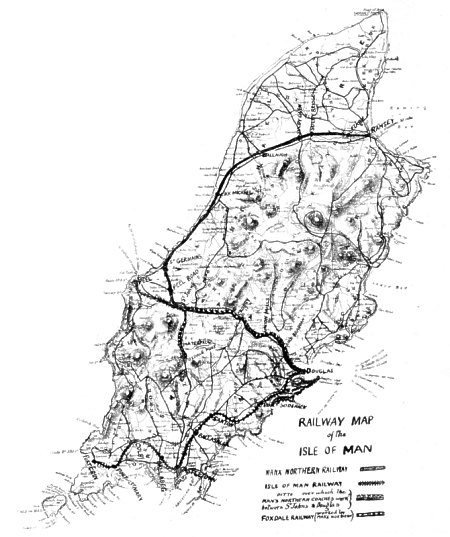
As previously stated the line is single, the passing places being Sulby Bridge, Ballaugh, and Kirk Michael. The stations, and also the eleven gatekeepers' houses, are substantially built of stone with slate roofs. We can scarcely expect the intermediate stations to be very pretentious, but they are somewhat better than those on the Isle of Man Railway, which usually consist of only a small erection, without platforms, these, however, are not necessary, as the bottoms of the carriages are not very far above rail level, and two footboards are provided. There are two viaducts carrying the railway, one across the Wyllyn Glen, and the other over Mooar Glen. They are both of the same design, and the former is illustrated; they have three spans of 60 ft. each, heavy lattice girders and massive stone piers. There are also several over-bridges on the Manx Northern Railway, although they are very scarce on the Isle of Man Railway, most roads crossing that line on the level. The trains are worked by means of staff and tickets, and semaphore signals are employed, those on the Northern Railway are actuated by the usual lever, but on the other line, a wheel, something after the style of a ship's steering wheel, is used for the purpose of raising and lowering the signals.
The line is worked in a very economical manner, the time tables being arranged so that the up and down trains usually meet at St. John's station, this enables the Manx Northern engine to bring one train down to the junction, and return at once with another to Ramsey. The Manx Northern Railway trains going towards Douglas are drawn up at that Company's platform at St. John's, the engine detached and the Isle of Man Railway train from - Peel backed on to the front of the former, so that no time is lost in shunting operations in either direction.
The rolling stock deserves attention. The Manx Northern Railway possesses but four engines, and these are of three distinct types (two of which we illustrate). No. 1 Ramsey and No. 2 Northern are of the same type, having a pair of leading wheels with radial axle boxes, and four-coupled wheels 3 ft. 9 in. diameter, the cylinders are outside, and measure 11 in. diameter by 18 in. stroke, the working-pressure is 120 lbs. per square inch, capacity of tanks 400 gallons, coal capacity 25 cwt., weight in working 18 tons. These two locomotives were built by Sharp, Stewart and Co. in 1879. No. 3 is named Thornhill, she has a leading bogie and four-coupled wheels, and was built by Beyer Peacock and Co. in 1880. Her outside cylinders are ii in. diameter, by 18 in. stroke, the other leading dimen-sions of No. 3 are 3 ft. 9 in. driving wheels, working pressure 120 lbs. per sq. inch carries I ton coal and 385 gals. water weight in working 18 tons. The remaining locomotive (No. 4) is named "Caledonia," she has six-coupled wheels, and was built by Dubs and Co. in 1885, the cylinders' dimensions are 132 by 20 in. stroke, wheels 3 ft. 3 in. diameter; other dimensions-working pressure 135 lbs. per sq. in., 30 cwts. coal, weight in work-ing 27 tons. This engine was specially constructed to work coal traffic to Foxdale.
The passenger rolling stock of the Manx Northern Railway consists of two 1st class, three (1st and 3rd class) composites, and ten 3rd class coaches, these are all 6-wheel vehicles; there are also two 4-wheel passenger break vans. The 3rd class carriages are each divided in compartments, seating five passengers on each side. The composite carriages provide accommodation for 20 1st class and 40 3rd class passengers. The1st class carriages each contain three compartments, these are particularly wide-between the seats-9 ft. from division to division. We understand originally a settee was provided in the centre of the compartments, but as these have been removed, 1st class passengers are treated to an amount of leg room not usually found in railway carriages. The upholstering and decoration is good, and safety latches are provided outside the doors (as is the practise on some Continental railways). The carriages are painted with chocolate lower and creamy-white upper panels (somewhat of the shade adopted by the London and North Western Railway). Centre couplers, of the double-hook variety, are in all cases employed, no side buffers being provided, although side chains are.
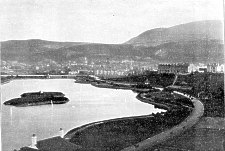
Ramsey, Isle of Man, with Barrule Mountain in the background
[actually shows Mooragh Park]
The railways in the island work in close harmony, and no difficulty is experienced on the Manx Northern Railway from the lack of passenger coaches during the busy season, as the carriages of the Isle of Man Railway are pressed into service on the North Manx Railway if the passenger traffic over the latter system is heavy.
Mr. McDowall, however, intends to improve the standard of passenger coaches, and has already ordered two composite bogie carriages; these are to be fitted with all the latest improvements including. electric light, they are being constructed by Hurst, Nelson and Company, Limited, Glasgow and Motherwell, and are expected to be ready for service in July. The principal dimensions of these up-to-date narrow-gauge carriages are
|
ft. in.
|
|
|---|---|
| Length over Mouldings |
35 6
|
| „ „ Headstocks |
35 0
|
| Width over Mouldings |
7 0¾
|
| Height from floor to underside of top roof |
6 9
|
| Height to top of cant-rail |
6 2
|
| Centres of Bogies |
26 0
|
| Wheel Base of Bogies |
4 6
|
| Diameter of Wheels |
2 3
|
The carriages to be mounted on steel frames with two bogies of American type.
They will consist of four 3rd and two 1st class compartments.
The goods rolling stock comprises 28 open and 4 covered wagons, 3 cattle and 2 timber trucks, or 37 in all.
No reasonable exception can be taken to the train service and speed, the former is liberal, exceedingly well arranged, and efficiently carried out; the timetable is arranged on an average speed of 25 miles an hour between stops, so that a fairly high rate is at times attained. There are ten trains each way daily between Ramsey and Douglas, besides intermediate local ones between Ramsey and the stations on the Manx Northern Railway. Fast trains, in connection with the steamers, cover the 26½ miles between Ramsey and Douglas in 68 minutes, including three stops, one of 5 minutes at St. John's, the others being at Ballaugh and Sulby Glen.
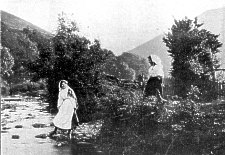
Stepping-Stones in Sulby Glen, near Ramsey, Isle of Man
['classic' G B Cowen image]
Douglas is the principal port of arrival and embarkation in Mona; but as the town caters largely for "trippers " from Lancashire and Yorkshire, the better class of visitors hardly appreciate the attractions of Douglas during the season, so they, together with families from all parts of the British Isles, usually proceed by the Manx Northern Railway to Ramsey, where special pains are taken to accommodate family parties and the more select visitors. But although the gayer sojourners prefer Douglas, with its dancing halls and other attractions, as a residential centre, the districts served by the Manx Northern Railway are so rich in romantic scenery and historical places that the various spots served by the line are generally visited by most people making a stay in Mona's Isle.
Passengers with through tickets between Douglas and Ramsey are allowed to break their journey at any station on the line.
The scenery about the northern district, of which Ramsey is the natural centre, and reached there-fore by the Manx Northern Railway, is in striking contrast to that of other parts of the island. Standing at the junction of two widely-separated rock formations, the appearance of the country north and south of the town is curiously unlike. Looking southward and westward, the sub-rock is a clay slate of the Lower Silurian Age, and forms a high mountain range which ends in the bold promontory of Maughold Head. From this point the range rolls inland in a long succession of rocky peaks, through Barrule, Clagh Ouyre, Snaefell, and others, to the western coast, forming one of the grandest mountain . landscapes in Britain. This mountainous background is broken by the series of beautiful sylvan glens-served by the Manx Northern Railway-such as Ballure, Cornah, Glen Mona, Ballaglass, Elfin Glen, Glen Auldyn, Sulby Glen, Ravensdale, Glen Willyn, Glen Helen, Glen Meay, and others less known, which add greatly to the beauty of. the district, and provide an inexhaustible supply of picturesque localities for pic-nic parties from the town and for wandering pedestrians. Looking northward, the outlook is strangely changed. The sub-rock is now a series of glacial and post-glacial deposits, chiefly of loose and unconsolidated sands and gravels; the mountains sink down abruptly into a low, fertile plain.
Elfin Glen, immediately behind Ramsey, is an ideal spot for a pic-nic party. Six miles west of Ramsey, on the Manx Northern Railway, and about the centre of the northern face of the mountains, is Sulby Glen-the "Manx Switzerland" -and two miles further still is Ballaugh Glen (or Ravensdale), both magnificent examples of Manx highland valley so. Glen Willyn is much frequented by pic-nic parties, and various kinds of amusements are provided. Light refreshments can also be had.
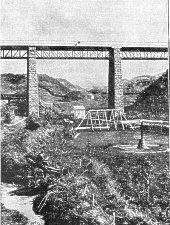
Viaduct carrying The Manx Northern Railway across Glen Willyn
Conveyances ply regularly between Sulby Glen Station and the Glen, also between St. John's Station and Glen Helen and Glen Meay.
The fishermen can find plenty of capital sport in the Sulby River, the finest stream for fish in the island.
Cyclists visiting Mona cannot do better than travel by train to Ramsey, and make that town their headquarters, as the roads in the north are especially good and suit-able for cycling. In the neighbourhood of Ramsey a rider may select many routes without hills, and he can ride for miles upon fine level well-kept roads.
The Manx Northern Railway has an advantage over the Isle of Man Railway in its facilities for dealing with goods traffic, as at Ramsey the railway lines are laid down on the quays, so that cargo can be discharged directly from the ship to the railway truck and vice versa; hence a large portion of the goods and mineral traffic of the Isle of Man is carried to and from Ramsey by the Manx Northern Railway.
During 1898, the Manx Northern Railway conveyed 166,152 passengers over its system. The paid-up capital of the undertaking is £31,239 18s. 11d. ordinary, £23,425 five per cent. "A" preference shares, and £25,000 five per cent. "B" preference shares. On the "B" shares the Government of the Island guarantees a dividend of four per cent., and the Manx Northern Railway provide one per cent. interest on this portion of its capital. The debentures of the railway amount to £40,000, and these have been raised at four per cent. The total amount expended on the railway to Dec. 31st, 1898, was £129,641 10s. 5d., so that £9,9761 is. 6d. has been over expended on capital account.
Earlier in this article we made mention of a third Manx railway, and this line is the bete noir and cause of all the misfortunes of the Manx Northern Railway. The line is known as the Foxdale Railway, a single line three and a half miles in length, running from St. John's, up the side of the Shenwhallin Mountain, to the Foxdale lead mines. The railway was incorporated in 1883. So tempting a tale concerning the advantages that would accrue to the Manx Northern Railway from working the Foxdalë line was told the directors of the former, that they leased the Foxdale Railway at 55 per cent. of the gross receipts of the line. Had this been all there would have been nothing to complain about, but the promoters of the Foxdale Railway persuaded the Manx Northern Railway that the latter would do so well out of the Foxdale line-by conveying the produce of the line over the whole length of the Manx Northern Railway for shipment at Ramsey, and bringing from Ramsey the whole of the coal and stores required at Foxdale -that the Manx Northern Railway agreed to pay the Foxdale people a large portion of the receipts which would accrue to the Manx Northern from its own traffic. How this arrangement has worked the following figures show more graphically than pages of explanation :-
| £ s d | |
| Amount received at 55 per cent. of the gross receipts by the Manx Northern Railway for working the Foxdale Railway during 1898 | 276 8 6 |
| (Out of this sum the Manx Northern Railway had to pay all expenses of working and maintaining the Foxdale Railway.) | |
| Rebate paid the Foxdale Railway by the Manx Northern Railway out of the earnings of the Manx Northern Railway during 1898 | 579 4 1 |
It is therefore evident that the Foxdale Railway got their line worked for nothang, and, in addition, received in hard cash from the Manx Northern Railway during 1898, £302 15s. 7d. ! ! whilst the total gross earnings from the Foxdale Railway during the same period only amounted to £489 l0s. 8d. ! ! ! without making any allowance for working. expenses or maintenance ! ! ! !
The Foxdäle Railway falls at one in 49 for its whole length to St. John's, and the line crosses over the Isle of Man Railway by means of a bridge east of St. John's Station, and curves sharply to the left, a separate station being provided for it at St. John's, adjacent to that of the other two railways ; the junction with the Manx Northern Railway is a short distance west of St. John's Station. There are only two passenger trains each way daily on the Foxdale Railway, but, consequent upon the station and junction being constructed as they are, the Manx Northern Railway has direct access to the Foxdale line without entering the system of the Isle of Man Railway, whilst the latter railway can only obtain access to the Foxdale Railway by means of the Manx Northern Railway metals. The Foxdale Railway is leased for. 50 years from Jan. 3rd, 1885, and already the Manx Northern Railway has sunk £6,400 Its. 9d. in the concern, by the annual payment of the share of the profits from working the Manx Northern Railway. The Foxdale Railway cost about o8,000 to construct, and is now worth about o2,500 ; it might, therefore, be to the advantage of the Manx Northern Railway to purchase the Foxdale, not as a remunerative investment, but to stop the yearly drain of its own meagre profits.
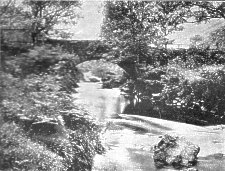
Sulby Bridge, Manx Northern Railway
Mr. David McDowall, Manager and Secretary of the Railway was appointed 15 months ago, and has made many desirable improvements.
The time occupied on the journey to Ramsey has been shortened. Preciously trains ran into and out of the Manx Northern Station at St. John's, but this has been rendered unnecessary by the introduction of a new platform at St. John's on the Main Line. The time allowed at stations has been reduced. Special trains have been run with mails when necessary in the stormy winter months, when steamers did not arrive in time for the ordinary trains. The Rolling Stock and Permanent Way have been improved, trees have been planted and flower gardens laid down at the intermediate stations, and at Ramsey the station has been decorated and beautiful shrubs planted.
The good effects of the new Manager's energy and enlightened policy are becom-ing apparent, the traffic receipts for the present year showing an increase of over 10 per cent. Mr. McDowall is a Scotch-man, and was for many years Assistant on the Wigtownshire Railway, now merged in the Portpatrick and Wigtownshire Joint Railways; subsequently he was Manager of the Ayrshire and Wigtownshire Railway, now the property of the Glasgow and South Western. At the time he was appointed Manager and Secretary of the Manx Northern Railway he was in the service of the Caledonian Company.
|
|
||
|
|
||
| Any comments, errors or omissions gratefully received The
Editor HTML Transcription © F.Coakley , 2016 |
||